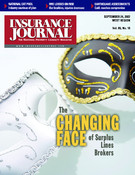Insurance executives expect to see a significant increase in mergers and acquisitions in the next 12 months, according to a survey conducted by KMPG LLP. In the next one to three years, most respondents believe the industry has a moderate ability to increase margins. Meanwhile, the survey reported executives believe strong company performance will be tempered by over-pricing and the negative impact of subprime mortgage woes.
At KPMG’s 19th annual Insurance Industry Conference held recently in New York, 59 percent of the 270 executives attending said they expect an increase in the number of mergers and acquisitions in the next 12 months, up significantly from 38 percent a year ago.
“Our recent surveys have found executives bullish on overall business performance, and this is translating into strategic opportunities for expansion,” said Scott Marcello, partner, Insurance Industry Leader at KPMG LLP. “The execs are telling us that business is good and that acquisitions and product innovation are key areas of focus.”
Another indication that executives anticipate increased mergers and acquisition activity came when they were asked about the highest priority of investment for their companies, to the extent that capital surplus is present. Forty-one percent of executives surveyed by KPMG believed the investment would first go toward strategic acquisition, followed by 30 percent who said technology. And, of the areas that they feel will be important for future growth, the executives cited product innovation at 33 percent, distribution at 14 percent and technology at 11 percent.
In 2006, 50 percent of respondents indicated they would have put capital surpluses toward technology. Thirty-eight percent would have put monies toward strategic acquisitions, and 12 percent would have put capital surpluses toward stock repurchases.
Fifty-five percent of the executives surveyed believed that the recent and emerging subprime issues will have an extreme or significant negative impact on the financial results and performance of the insurance industry. Seventy-three percent of executives did, however, indicate that they were confident that their companies had a firm grasp on their exposure to the subprime market and related risks. Only 9 percent were not confident at all that their companies understood the exposure to the subprime industry and related potential losses. And 44 percent believed emerging subprime issues would have no impact at all on the industry’s financial results and performance.
When asked about areas of significant risk impacting their industry in the next three to five years, 56 percent indicated pricing, followed by credit risk at 17 percent would have the largest impacts. One year ago, executives believed pricing and regulatory/market conduct risks posed the greatest threats.
With regard to their outlook on premium growth, KPMG’s survey found the executives much more optimistic about the life and health insurance space than the property and casualty industry. Fifty-four percent expected premium growth in life and health, while only 30 percent expected an increase in property and casualty. Another 43 percent indicated they believed premium growth in property/casualty would decrease. Seventy-two percent believed the industry had a strong or moderate ability to increase margins in the next few years.
In 2006, 42 percent expected P/C premium growth to increase, and 31 percent expected it to decrease. And 67 percent believed the industry had a strong or moderate ability to increase margins in the next one to three years.
In response to a question about how they expect their firms to perform in the coming year compared to the past 12 months, 53 percent of executives anticipated performance will beat expectations, down slightly from 59 percent a year ago. Thirty-nine of executives said they expected their firms this year to perform as they did in 2006.
The decline in optimism might be caused by the fact that the subprime issue and pricing risks remain significant concerns among insurance executives, KPMG indicated.
The most important areas for future growth are product innovation (33 percent), followed by distribution (14 percent) and technology (12 percent), the executives indicated. In 2006, survey respondents believed technology, international expansion and distribution were most important.
KPMG LLP, an audit, tax and advisory firm, conducted the real-time survey of 270 senior executives at its 19th Annual Insurance Industry Conference held at the Roosevelt Hotel in New York, on September 11 and 12.
For more information, visit www. us.kpmg.com.
Topics Tech Property Casualty Market
Was this article valuable?
Here are more articles you may enjoy.


 SIAA Announces Strategic Partnership With Progressive
SIAA Announces Strategic Partnership With Progressive  Door of Swiss Bar Where 40 Died in Fire Was Locked, Says RTS
Door of Swiss Bar Where 40 Died in Fire Was Locked, Says RTS  Wildfires, Storms Fuel 2025 Insured Losses of $108 Billion: Munich Re Report
Wildfires, Storms Fuel 2025 Insured Losses of $108 Billion: Munich Re Report  CEOs on Guard as Trump Rattles Companies With Series of Edicts
CEOs on Guard as Trump Rattles Companies With Series of Edicts 


